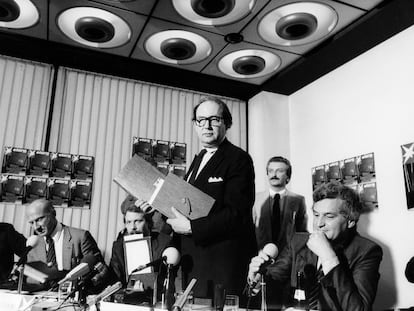Rudolf-Christoph von Gersdorff: The Nazi official who tried to kill Hitler 80 years ago
His was only one of several attempts made by German army officials, and he was one of the few conspirators that survived the war

Between 1943 and 1944, there were at least five attempts to bring one of the German conspirators close enough to Adolf Hitler to try to kill him. On March 21, 1943, 80 years ago, Rudolf-Christoph von Gersdorff, a German army officer, willing to die to free his country from Nazism, made one of these attempts. Although he failed, his account shows us more about the opposition to Hitler within German military lines, and the bravery of those involved.
Before the attack
Gersdorff began his military career in Germany in 1925, in the 7th Cavalry Regiment, and became a regimental adjutant in Breslau in 1933. In 1938, he transferred to the War Academy in Berlin, and was part of the occupation of Sudetenland (areas of Czechoslovakia that Germany wanted to annex). Later, in 1939, his unit was deployed during the invasion of Poland, and he acted as a staff officer in the offensive against France.
From 1941 he became a counterintelligence officer of the Heeresgruppe Mitte (Army Group Center), where he joined a group of conspirators who were informed about war crimes against Soviet prisoners of war and the mass murder of Jewish people by Einsatzgruppe B (one of Germany’s paramilitary death squads).
Among the conspirators was Henning von Tresckow, a key figure in the German army resistance, who was recruited by Friedrich Olbricht, a lieutenant general, who was also involved in the plans to overthrow Hitler. It was Olbricht who developed a blueprint for a coup d’état, which defined a clear structure of what the government would look like after Hitler’s death.
Originally, the plan to assassinate Hitler was to be carried out by Tresckow under Olbricht’s direction from Berlin. On March 13, the dictator was to visit soldiers on the Eastern Front in Smolensk. There, a group of officers would shoot him at the same time after a signal. However, Günther von Kluge, a commander of the Center, asked Tresckow to cancel the plan, pointing out that it was too early and that, in the absence of Heinrich Himmler (a key figure of the SS, and one of Hitler’s closest men), the event could result in a civil war between the SS and the German army.
Having failed, Tresckow attempted another assassination by placing a bomb on a plane in which Hitler would be traveling. However, it was not detonated.
The plan of March 21
After Tresckow’s failed plan, Gersdoff indicated that he was willing to give his life for Germany in another assassination attempt. On March 21, 1943, Hitler was to visit the Berlin Zeughaus, an old armory where Soviet weapons were stored. This visit was part of Heldengedenktag, a public holiday commemorating those who had fallen in military engagements. Because it was so important, the dictator was expected to spend considerable time at the site, making it an ideal place to carry out another assassination attempt.

Gersdorff was the guide for Hitler’s visit to the Zeughaus. Previously, the officer had obtained explosives, which he placed in his coat pockets, and set them off for a 10-minute detonation. His plan was to throw himself on Hitler in an embrace that would result in an explosion that would kill them both, and possibly others in attendance, including Heinrich Himmer, Hermann Göring, Wilhelm Keitel and Karl Dönitz, all close to Hitler.
However, the Nazi leader rushed through the museum in less than 10 minutes, leaving the building quickly. Gersdorff was left with the bombs and managed to disarm them at the last minute. He was subsequently sent to the Eastern Front to avoid suspicion.
Gersdorff also obtained explosives that would later be used by another conspirator, Claus Schenk Graf von Sauffenberg, for the 20 July Plot, better known as Operation Valkyrie.
The officer was one of the few conspirators to survive the war, with others being imprisoned and tortured. Thanks to their silence, Gersdorff avoided arrest and execution.
After the war
After the war ended, Gersdoff participated in the U.S. Army Historical Division, where German generals wrote operational studies of World War II.
Being considered a traitor by some officers, he was rejected from the Bundeswehr, the West German armed forces, which prevented him from continuing his military career.

He dedicated his life to charity in the Order of St. John, a branch of a Catholic military order, founding a humanitarian organization that as of 2017 had 37,000 active volunteers and more than 1.3 million registered members.
Although Gersdorff has been viewed in a positive light because of his involvement in the opposition to Hitler, in recent years his image has come under scrutiny. Historian Joannes Huerter, of the Institute of Contemporary History in Munich, pointed out that in the beginning many of the conspirators were informed of the first mass murders, and they collaborated in them, since these crimes seemed a lesser evil when weighed against the chance of defeating the Soviet Union. Once they noticed that the military risk was not worth it and that the murders turned into genocide, they reconsidered their position.
Sign up for our weekly newsletter to get more English-language news coverage from EL PAÍS USA Edition
Tu suscripción se está usando en otro dispositivo
¿Quieres añadir otro usuario a tu suscripción?
Si continúas leyendo en este dispositivo, no se podrá leer en el otro.
FlechaTu suscripción se está usando en otro dispositivo y solo puedes acceder a EL PAÍS desde un dispositivo a la vez.
Si quieres compartir tu cuenta, cambia tu suscripción a la modalidad Premium, así podrás añadir otro usuario. Cada uno accederá con su propia cuenta de email, lo que os permitirá personalizar vuestra experiencia en EL PAÍS.
¿Tienes una suscripción de empresa? Accede aquí para contratar más cuentas.
En el caso de no saber quién está usando tu cuenta, te recomendamos cambiar tu contraseña aquí.
Si decides continuar compartiendo tu cuenta, este mensaje se mostrará en tu dispositivo y en el de la otra persona que está usando tu cuenta de forma indefinida, afectando a tu experiencia de lectura. Puedes consultar aquí los términos y condiciones de la suscripción digital.
More information
Archived In
Últimas noticias
Most viewed
- Sinaloa Cartel war is taking its toll on Los Chapitos
- Reinhard Genzel, Nobel laureate in physics: ‘One-minute videos will never give you the truth’
- Oona Chaplin: ‘I told James Cameron that I was living in a treehouse and starting a permaculture project with a friend’
- Why the price of coffee has skyrocketed: from Brazilian plantations to specialty coffee houses
- David King, chemist: ‘There are scientists studying how to cool the planet; nobody should stop these experiments from happening’











































